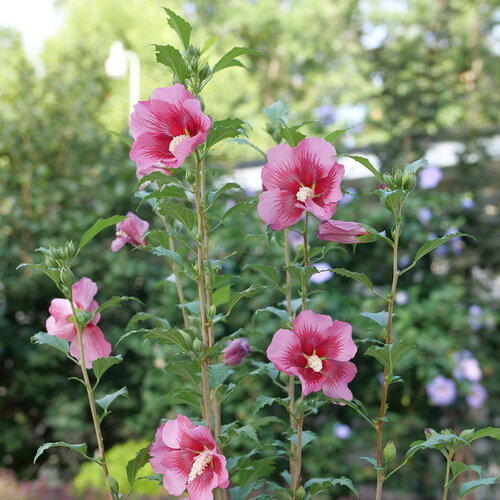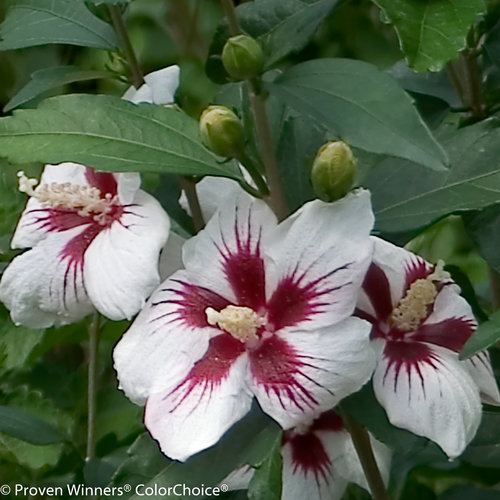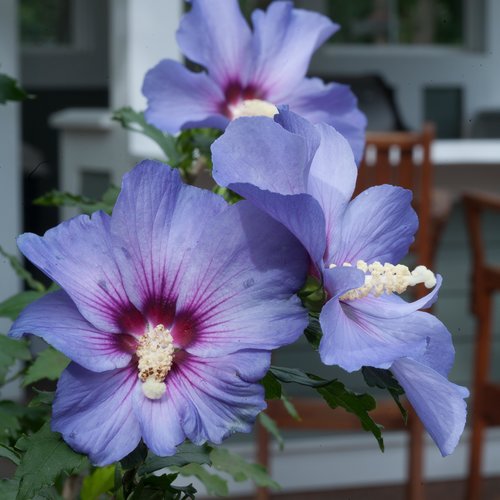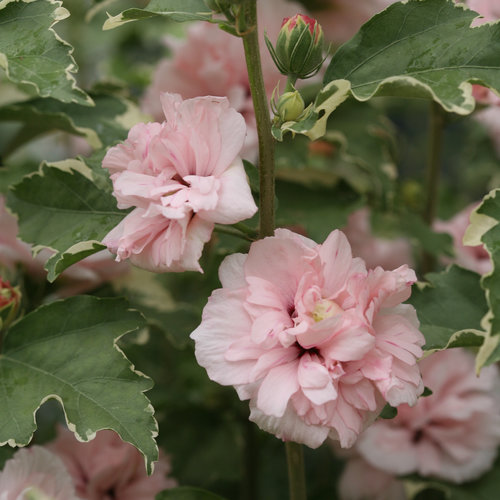How to Grow Hibiscus in Pots - The Ultimate Guide from Proven Winners®
These flowering plants are not just for landscapes. Grow hibiscus in pots on a sunny patio, deck or apartment balcony for long lasting summer color.

Buy hibiscus plants - Order online and have them shipped right to your door
Hibiscus is a versatile group of plants that includes herbaceous perennials, woody shrubs, and tender broadleaf evergreens. These showy plants are prized for their exotic, trumpet-shaped flowers that bloom from mid-summer into fall. With some varieties producing blooms up to 12 inches wide, they bring a bold, tropical flair to gardens and tropical hibiscus pots.
The most commonly grown hibiscus varieties include both hardy and tropical types. Rose of Sharon (Hibiscus syriacus) is a deciduous shrub hardy to USDA zones 5-9. Rose mallow (Hibiscus moscheutos) is a herbaceous perennial that dies back to the ground in winter, and is hardy in USDA zones 4-9. Tropical hibiscus pots (Hibiscus rosa-sinensis) is hardy in USDA zones 9-12, depending on the variety, and is sensitive to temperatures below 50 degrees F.
This popular landscape shrub can also be grown in pots and is easy to care for when given the right type of container, rich soil, plenty of water and light. Hibiscus care in containers is simple once you understand their needs. Hibiscus planted in pots are useful where space is limited, making an attractive focal point on an apartment balcony, patio or deck.
Keep reading to find out more on how to plant and grow hibiscus in pots successfully.
HIBISCUS CARE IN POTS
Potted hibiscus care is somewhat different than for plants in the ground. Follow these growing tips for lush, beautiful potted plants.
Container Choice
When growing hibiscus in pots, plants prefer to have their roots a bit crowded. Choose a container that is 1 to 2 inches wider and deeper than the root ball. Select a sturdy pot made of plastic, composite, clay, stone, ceramics or cement. Pots made of lighter materials will be easier to move around. Make sure containers have adequate drainage holes in the bottom to prevent root rot.
Light
While you can site these plants in afternoon shade, all species of hibiscus love full sun and can handle it all day—even in hot climates—as long as they’re kept well-watered. Note: when growing hibiscus in a container in a very hot climate, the roots can overheat. It might seem that the plant is stressed from the sun when, in actuality, it’s a watering/heat retention issue. The key to successful potted hibiscus care is providing some light afternoon shade or using a larger, insulated container can help in those cases. Keep the roots cool and moist. If pots are placed up against a wall, fence or other area that blocks sunlight, turn plants every week or two so they grow evenly on all sides.
Soil
Hibiscus care in containers need lightweight soil that drains well in order to thrive. Garden soil is too heavy and compacted for container use, impeding the flow of water and nutrients to the roots. It can also contain harmful pathogens that can cause disease. Soil for tropical hibiscus in pots should consist of a high-quality soilless potting mix or potting soil that contains materials such as peat moss, perlite, vermiculite or coco coir, which are lighter and will improve drainage.
Proven Winners® Premium Potting Soil contains a superb blend of all the ingredients your hibiscus needs to flourish.
Fertilizer
While tropical hibiscus will do well with a high potassium fertilizer, it’s important to note they need a mix with very little phosphorous, which ties up nutrients in the soil that they need to thrive. Resist the urge to use fertilizers that promise more or larger blooms, as these are not formulated correctly for exotic hibiscus. A medium amount of nitrogen is also best. An NPK of 17 (nitrogen) – 5 (phosphorous) – 24 (potassium) is ideal for these types of hibiscus. There are many products available that specify they are for tropical hibiscus pots that would work.If you are using Proven Winners fertilizer, the slow-release fertilizer is the best formulation for these types of plants. When fertilizing tropical hibiscus in pots, make sure the soil is already moist, so the nitrogen doesn’t burn the plant. Following these simple steps ensures reliable potted hibiscus care and sustained bloom performance.
Water
In general, shrubs in containers will need more water than ones in the ground. Try not to let the soil dry out for too long. Use a water meter, or a finger sunk 3 inches or more into the soil, to determine when it is almost dry. Apply water until you see it come out of the bottom. If the soil has dried out considerably, plan to water twice. Wait a few minutes between the first and second waterings to let the soil soak up the water. Following this hibiscus care in containers will help you grow hibiscus in pots successfully.
Tropical hibiscus never likes to be dry – ever. You can safely water these thirsty, sun-loving plants every day.
PLANTING HIBISCUS IN POTS
Spring is the best time for planting hibiscus. Wait until all danger of frost is past in your area. Follow these steps to plant hibiscus in pots.
- Place 1 to 2 inches of potting soil in the bottom of the container.
- Remove hibiscus plant from its nursery pot and gently tease out roots if pot-bound.
- Set the plant in the container with the top of the root ball 1 to 2 inches below the rim of the pot.
- Add potting soil around the sides of the root ball and gently tamp down to remove air pockets.
- Continue adding soil until it reaches the base of the stem.
- Water until moisture comes out of the drainage holes at the bottom of the pot.
HIBISCUS VARIETIES FOR CONTAINERS
Choose one of these hibiscus varieties to plant in a container on your patio, deck or balcony:
Blue Chiffon® Rose of Sharon  | |||
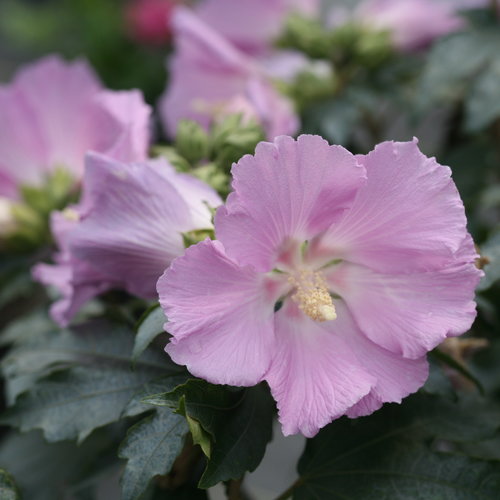 Pollypetite® Pollypetite®Rose of Sharon |  |  | |
 Hollywood Hibiscus™ Rico Suave™ |  Hollywood Hibiscus™ First Lady™ |  Hollywood Hibiscus™ Sunset Boulevard™ |  Hollywood Hibiscus™ Disco Diva™ |
FAQ's
How often to water hibiscus in pots?
Hibiscus prefer evenly moist soil and don’t like to dry out. The frequency of watering depends on several factors, including the size of the pot, air temperature and type of container. Clay pots are porous and dry out more quickly.
Potted hibiscus typically need to be watered every 1 to 2 days. Check plants daily. If the soil is dry 1 to 2 inches deep, it’s time to water. Drench the soil surface until excess water begins to flow out of the bottom of the pot. Plants may need daily watering during heat and dry spells. Avoid overwatering to prevent root rot.
To simplify watering chores, try Proven Winners® self-watering AquaPots® or install our WaterWise® drip irrigation system.
How to prune hibiscus in a pot
Hibiscus bloom on new growth and need minimal pruning. In late winter or early spring, cut out any dead, diseased or broken branches and lightly shape plants as needed. Avoid pruning later in the growing season, which will result in a loss of flower buds.
How long can hibiscus live in pots?
Hibiscus plants can grow quickly and become quite large, so will likely need to be transplanted into a bigger pot every 2 years. In early spring, remove the plant from its pot and check the root ball. If the roots are tightly compacted, it’s time to transplant.
Hardy hibiscus plants will eventually need to be planted in the ground, though dwarf varieties such as Pollypetite may be kept in larger pots even when they reach their full size. When grown in USDA zones 10-12, tropical hibiscus varieties may also be transplanted into the ground when they become larger.
Do hibiscus do better in pots or in the ground?
Smaller specimens will thrive either in pots or the ground when given the right growing conditions. Larger specimens will perform better when planted in the ground.
What to do with potted hibiscus in winter?
Tropical hibiscus is sensitive to colder weather. When temperatures dip to 50 degrees F, bring potted hibiscus plants indoors for the winter. Before bringing plants inside, inspect leaves and stems for insect pests and gently spray with water to dislodge pests, dirt and pollen.
Place potted hibiscus plants in bright indirect light near a sunny window away from drafts. Reduce watering and fertilizing until spring. Keep an eye out for indoor pests such as aphids, mealy bugs or scale and treat plants as needed with insecticidal soap or neem oil. In spring when minimum temperatures reach 50 degrees F or higher, move plants outside and slowly acclimate to outdoor conditions.
Hardy hibiscus in pots will go dormant in winter and should be overwintered outside. In order to survive outdoors in winter, potted plants should be two zones hardier than the climate zone you live in. Make sure plants are in containers made of plastic, composite, metal or wood that won’t crack in freeze-thaw weather cycles. Larger pots will offer more protection to the roots than smaller ones.
Place pots in a sheltered spot against your house or other building out of the wind. For additional protection, pots can be covered with a mulch of fallen leaves or straw held in place with plastic sheeting. Cease fertilizing while plants are dormant. Check pots periodically throughout the winter to make sure the roots don’t dry out completely and water plants sparingly as needed.
When plants begin to break dormancy in early spring, remove mulch, place plants in brighter light and resume watering and fertilizing.
If potted plants are hardy to your zone or one zone colder, they can be overwintered in an unheated garage. They can also be transplanted into the ground in fall and mulched for winter protection.
Learn more about overwintering potted perennials and shrubs.
Want to learn more?
How to Grow Hydrangeas in Pots



